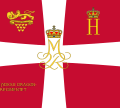Jutland Dragoon Regiment
The Jutland Dragoon Regiment (Danish: Jydske Dragonregiment) is the only regiment of the Royal Danish Army that has an armored (MBT) battalion, and is one of the Danish combat regiment in which soldiers are entitled to wear the black beret of the Armoured corps.
| Jutland Dragoon Regiment | |
|---|---|
| Jydske Dragonregiment | |
 Coat of arms | |
| Active | 1 November 1679–present (340 years, 7 months) |
| Country | |
| Branch | |
| Type | Armor |
| Role | Armoured warfare and Mechanized infantry |
| Size | Three battalions |
| Part of | Army Staff |
| Garrison/HQ | Holstebro |
| Nickname(s) | JDR Dino'er |
| Motto(s) | Fortes Fortuna Juvat (Fortune favours the Brave) |
| March | Danmarks Blå Dragoner (Denmark's Blue Dragoons) |
| Anniversaries | Formation (1 November 1679) The Rytterfægtning by Rosengarten (12 Oktober 1813) Battle of Rahlstedt (6 December 1813) Battle of Sehested (10 December 1813) Niels Kjeldsen's Battle by Højen (28 February 1864) Rytterfægtningen at Vorbasse (29 February 1864) |
| Engagements | Second Nordic War (1657−60) Scanian War (1675−79) Great Nordic War (1700 & 1709−20) First Schleswig War (1848−51) Second Schleswig War (1864) Operation Weserübung-Süd (1940) Operation Bøllebank (1994) War in Kosovo (1998−1999) War in Afghanistan (2001–present) Iraq War (2003−07) |
| Website | Official website |
| Commanders | |
| Current commander | Colonel Anders Poulsen |
| Ceremonial chief | HM The Queen |
| Notable commanders | Col. Lars Møller |
| Insignia | |
| Regimental belt | |
| Standard |  |
History
The Regiment traces its roots back to the 3rd Dragoon Regiment formed in 1657, but did not become the Jutland Dragoon Regiment until 1932, with the amalgamation of the 3rd Dragoon Regiment in Århus and the 5th Dragoon regiment in Randers. The regimental fusion eventually necessitated a relocation to Holstebro in 1953, where the Dragoons have remained ever since.
The Regiment acquired international fame in recent time, when it served with UNPROFOR in Bosnia, where the Dragoons of Jutland assaulted Serb AT-3 Sagger positions in one of the largest skirmishes between UNPROFOR forces and military units involved in the war in Bosnia, and the largest Danish battle engagement since The Second Schleswig War of 1864. The battle, known as Operation Bøllebank,[1] was later characterized by the commander at the time as the time when "the mouse ate the cat".
On July 19, 2005, another traditional regiment, Prinsens Livregiment was merged with Jydske Dragonregiment, and personnel serving as Dragoons became entitled to bear the insignia of the Royal Danish Prince Consort, Henrik, Prince Consort of Denmark
From the 1960s to 2004 the regiment had responsibility for three armoured battalions, one reconnaissance battalion and three motorized infantry battalions. The three armoured battalions were assigned to different brigades, the recce battalion and later (1992) one armoured battalion as independent battalions in Danish Division. From 1992−2004 the regiment also had to form three light reconnaissance squadrons assigned to three of the five brigades. With the three infantry battalions and regimental staff, in war time, the regiment could form a battlegroup, with combat support/artillery troops from other regiments.
The regiment has in recent time served on the frontline in Danish involvements in Yugoslavia, Kosovo, Afghanistan and Iraq.
The regiment's tank battalion won the Top 120mm Fire Team category at the Ex Worthington 16 competition in 2016, held at CFB Gagetown in Canada.
The Regimental logo is inspired by the coat of arms of Denmark, and features a blue lion above nine red hearts, and the monogram C5, in reference to King Christian 5th who ordered the formation of the original 3rd Dragoon Regiment. The lion and its red hearts are also a symbol of Jutland and are featured on the stern of Fregatten Jylland.
Structure
The regiment today serves only in its armoured role as well as in an educational role for new conscripts, in a separate battalion.
- Units














- Disband Units




Names of the regiment
| Slesvigske nationale Rytterregiment | Schleswig's National Cavalry Regiment | 1670 | – | 1675 |
| Holstenske (Slesvigsk-holstenske) nationale Rytterregiment | Holstein's (Schleswig-Holstein) National Cavalry Regiment | 1675 | – | 1678 |
| Slesvigske nationale Rytterregiment | Schleswig's National Cavalry Regiment | 1678 | – | 1681 |
| 2. Fyenske nationale Rytterregiment | Funen's 2nd National Cavalry Regiment | 1681 | – | 1763 |
| Fyenske geworbne Dragonregiment | Funen's Recruited Dragoon Regiment | 1763 | – | 1772 |
| Fyenske Regiment Ryttere | Funen's Regiment of Riders | 1772 | – | 1785 |
| Fyenske Regiment Dragoner | Funen's Regiment of Dragoons | 1785 | – | 1796 |
| Fyneske regiment lette Dragoner | Funen's Regiment of Light Dragoons | 1796 | – | 1842 |
| 6. Dragonregiment | 6th Dragoon Regiment | 1842 | – | 1865 |
| 3. Dragonregiment | 3rd Dragoon Regiment | 1865 | – | 1932 |
| Jydske Dragonregiment | Jutland Dragoon Regiment | 1932 | – | present |
References
- Raids magazine
- Laursen, Ole (22 April 2014). "Historical Overview of Jutland Dragoon Regiment". Wadschier. Retrieved 17 April 2020.